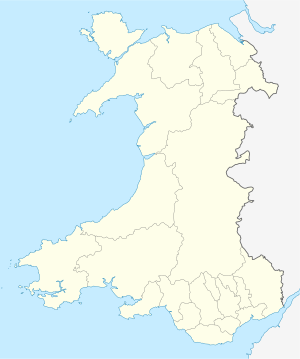Severn tunnel
| Severn tunnel | ||
|---|---|---|
|
Tunnel entrance
|
||
| use | Railway tunnel | |
| place | under the Severn estuary | |
| length | 7008 m | |
| Number of tubes | 1 (2-track) | |
| construction | ||
| Client | Great Western Railway | |
| start of building | 1873 | |
| completion | 1886 | |
| business | ||
| operator | South Wales Main Line | |
| release | January 9, 1886 | |
| location | ||
|
|
||
| Coordinates | ||
| West portal | 51 ° 35 ′ 6 " N , 2 ° 45 ′ 4" W. | |
| East portal | 51 ° 33 ′ 57 " N , 2 ° 39 ′ 28" W. | |
The Severn Tunnel ( Wal . : Twnnel Hafren ) is a double-track railway tunnel on the South Wales Main Line under the mouth of the River Severn . It connects South Gloucestershire in west England with Monmouthshire in south Wales . It was built from 1873 to 1886 by the Great Western Railway . Its total length is 7008 m, of which 3620 m are below the river mouth. This makes it the second longest railway tunnel in Great Britain . It was the longest tunnel in Great Britain until the opening of the second section of High Speed One .
planning
Before the tunnel was built, the Bristol area was linked to South Wales by ferries . The railroad was forced to make a long detour via Gloucester ; alternatively, passengers and freight could only be shipped at great expense. The increasing coal production in Wales in the second half of the 19th century also required new transport routes. The Great Western Railway planned to build the tunnel under "The Shoots", a relatively narrow but also extraordinarily deep point of the Severn Estuary. This required a steep incline of the access ramps, which is unusual for railroads, in order to get to the required depth.
construction
Work on the tunnel began in March 1873 and progressed slowly in the following years until 1879. In October 1879 there was a major water ingress on the Welsh side ("the Great Spring"), which could not be properly closed due to the geological formation and the work was delayed again and again in the following years. During a spring flood on October 17, 1883, the driveways, some of which were already completed but not yet connected to the tunnel, were flooded.
Due to pump defects and insufficient pumping capacity of the existing pumps, the tunnel or individual segments were under water several times during the construction phase. In two incidents, the water penetrated so quickly that the workers could no longer close existing locks in time. This was then accomplished through the use of divers to limit the water entry from the affected segments. So-called rebreather diving devices were also used for the first time during these diving missions, as the tracking of the breathing hoses that had been common up to that point proved to be problematic due to the length of the route to be covered. The breakthrough to the continuous tunnel tube took place on October 17, 1884.
-
Material usage:
- 76,400,100 bricks
- 36,794 tons of concrete
- 250 tons of tonite (an explosive)
completion
The tunnel was completed in 1885 and was first used by a freight train on January 9, 1886. Regular operation could only be started after the installation of large pumping stations, which still had to pump out water that was constantly seeping in at various points, but above all at the water ingress that was never completely sealed from 1879. In September 1886 the tunnel was finally opened for freight trains and from December also for passenger trains. The tunnel cut the travel time from London to Cardiff by around an hour.
Further development
The original steam-driven pumping stations were only replaced by electrical systems in the early 1960s. These still pump up to 50,000 m³ of water out of the tunnel every day. Freight traffic has declined sharply with the closure of most of the Welsh coal mines, but the tunnel remains an integral part of the UK rail network.
literature
- Thomas A. Walker: The Severn Tunnel: Its Construction and Difficulties (1872-1887) . First edition. 1888. (Reprint: 1990, ISBN 1-85026-014-1 ; new edition. Nonsuch Publishing, Stroud, England 2004, ISBN 1-84588-000-5 ) (Walker was the building contractor after the water ingress in 1879)
Web links
- History of the tunnel from the Great Western Archive


